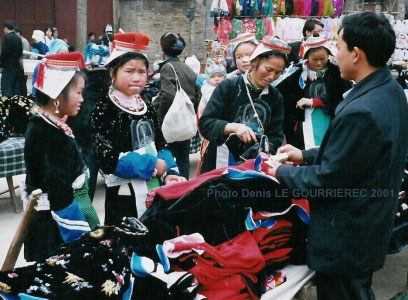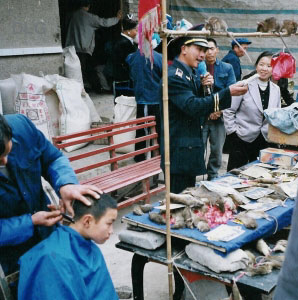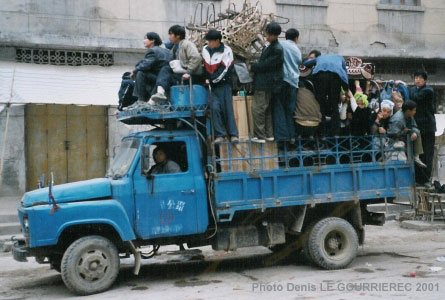|
Everywhere in the world, people buy, people sell.
In the muslim countries I visited, the bazaars are often situated in
long covered alleys, sheltered from the heat. In Kashgar, the famous
sunday market offers endless opportunities to stroll in a maze of passageways
and around large open spaces packed with cattle where the local Uighur
settle their transactions. But there are also small markets, in small
towns, where people from surrounding villages, often from different
ethnic groups, converge every 5 or 6 days. Women from each nationality
have wear the traditional dress, often very colourful. One of these
small markets, in a small town in Guizhou, a province in the south of
China, was fascinating ...
My small, cold hotel room overlooks the streets. I
woke up to the noise of ducks, squealing pigs, roaring trucks and tractors.
It's market day and the small town is jam packed with sellers and buyers
from nearby villages. Buses come from the main road, the roof loaded
with ducks or chicken packed in bags or bamboo cages, vegetables and
sometimes a dead pig. From the smaller roads come trucks and tractors,
full of people, and from everywhere converge more people on foot. Many
balance two cages tied to a yoke on their shoulder, with more ducks
and chickens inside, amongst them a man pulls along a buffalo, oblivious
of its fate. Piglets sometimes arrive in baskets at the back of a bicycle.
Soon the small town is teeming with people. They come
from two ethnic groups. The Miao or Hmong are related to the Mong of
Laos and Vietnam, and in this area all Miao women wear blue colours.
Women from the other ethnic group, the Gejia, wear an white and orange
headdress. Market day is not only time to sell or buy, but also a chance
to get a haircut or a tooth fixed. It is also the occasion for the people
to meet, so the best dress is mandatory, especially for young girls.
It is a misty cloudy dull day, typical of Guizhou, but the colours are
nevertheless striking.

Space is scarce, every single street is busy. The
river is low at this time and stalls even spread on its rocky bed. I
join the queue to walk across it on the stepping stones, and reach the
area where Miao women in blue and black busy make, embroider and sell
red and blue baby hats with silver decorations, red caps for young boys.
Stalls of blue and white scarves join this colourful dispaly. A little
further is a group of men. Each brought his singing bird in a cage and
all are squatting or standing around the cages looking fascinated, listen
with great attention. Next to this are sold ducks and geese in small
bamboo enclosures, chickens with their legs tied up, pigs tied to a
stake by a rear leg squealing while pulling on the rope, rabbits that
say nothing and miserable looking dogs. The most unlucky animals will
meet later in the cooking pot. A little further is the meat market,
no place for the faint hearted. Nothing is hidden, the slaughter is
done in front of the customer. A pig lies on a stall, slit open in half
lengthwise and all organs neatly exposed or hung on a railing above
it. The buffalo I saw earlier is not far, it's lying on the ground,
it has just been bled in a corner. Hungry ? good, soups are served next
to this at some small food stalls and a little further Miao ladies in
blue sell green vegetables : could'nt you hope for fresher products
? Spices ? no problem, just pass the vegetable stalls.
Then I come to the main street, lined with stalls
of all sort : watches, clocks, soap, washing powder, shoes, clothes,
anything. People try to move through a solid crowd, like this man struggling
to push a wheelbarrow with a dead pig on it. Straight across is a small
square, and the section for clothes, embroidered headdresses, black
velvet and more fabrics in all shades of blue. Black, blue and orange
colours dominate the scene. I turn on another street where I find dentists,
at work behind a table lined with teeth and solutions. Sometimes the
drill is driven with with the foot by a mechanism derived from old sewing
machines. RRRRrrrrr.... Up the same street are sold bed frames.  Back
towards the centre of town, I come across the barbers. Right next to
someone getting a haircut is a stall of a different kind. Standing behind
a table covered with dead rats, while live rats trot on a bamboo frame,
a man in a uniform is speaking in a microphone, he is selling ratpoison.
I continue, passing a lady getting an accupunture treatment at a stall
of traditional medecine, a doctor with explicit models of the human
body, and I am back to the poultry section. I see behind it that the
buffalo has been taken care of : only some skin is left in the corner. Back
towards the centre of town, I come across the barbers. Right next to
someone getting a haircut is a stall of a different kind. Standing behind
a table covered with dead rats, while live rats trot on a bamboo frame,
a man in a uniform is speaking in a microphone, he is selling ratpoison.
I continue, passing a lady getting an accupunture treatment at a stall
of traditional medecine, a doctor with explicit models of the human
body, and I am back to the poultry section. I see behind it that the
buffalo has been taken care of : only some skin is left in the corner.
I return to the clothes market, as I had missed one
corner of the small square leading to narrow streets where sellers of
charred wood and metal tools gather. Further on a bridge a few men are
sitting, selling some ropes. A large group surrounds an artist. He is
painting flowers or bamboo on a white board with his finger and the
help of a small baloon, using what looks more like wet mud or earth
than paint. While talking with the admirating crowd, he wipes away each
painting and he starts another immediately. Just around the corner,
women are sitting against a wall on small stools, their faces hidden
under a scarf. They are reading the future in the hands of other women,
sitting in front of them.
It is mid-afternoon and people are starting to leave
town. I walk to a street where trucks and tractors are parked. Men and
women squeeze in at the back, standing on bags among baskets and furniture.
A few more are sitting on top of the cabin. Others are hanging on the
sides or at the back of the truck. One after the others, the trucks
leave with their load of people and products. Other villagers return
on foot carrying their burden, sometimes a few chicken in each hand,
sometimes a heavy bag of rice on the back. By dusk, the streets are
empty. I share a hotpot with locals in a little restaurant, then I return
to the same cold, damp room of my concrete hotel.

see more photos from South-West China
|

 Back
towards the centre of town, I come across the barbers. Right next to
someone getting a haircut is a stall of a different kind. Standing behind
a table covered with dead rats, while live rats trot on a bamboo frame,
a man in a uniform is speaking in a microphone, he is selling ratpoison.
I continue, passing a lady getting an accupunture treatment at a stall
of traditional medecine, a doctor with explicit models of the human
body, and I am back to the poultry section. I see behind it that the
buffalo has been taken care of : only some skin is left in the corner.
Back
towards the centre of town, I come across the barbers. Right next to
someone getting a haircut is a stall of a different kind. Standing behind
a table covered with dead rats, while live rats trot on a bamboo frame,
a man in a uniform is speaking in a microphone, he is selling ratpoison.
I continue, passing a lady getting an accupunture treatment at a stall
of traditional medecine, a doctor with explicit models of the human
body, and I am back to the poultry section. I see behind it that the
buffalo has been taken care of : only some skin is left in the corner.








